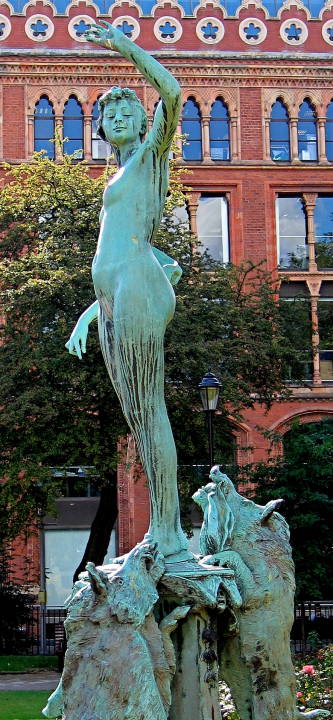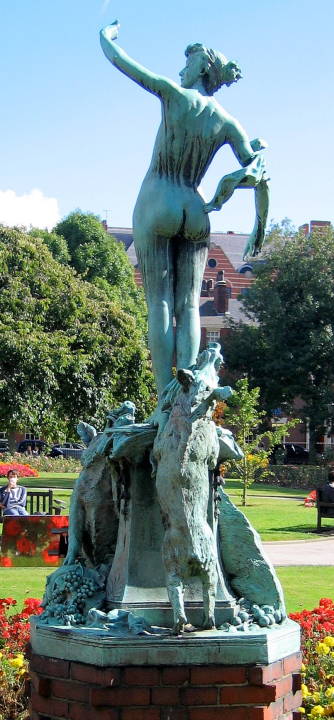Mr. Drury is among the most personal of our sculptors, always in search of the graceful, the tender, the placid, and the harmonious, caring nothing for the vigour of energy, for passion, or for anatomical display with which many love to express their enthusiasm or to display their knowledge. As a lad he was a choir boy at New College, Oxford; then, prompted by the sight of Chantrey's works, he attended the Art Schools in that city, and afterwards the National Art Training School, where he came under the influence of Jules Dalou, at that time the modelling master, as already explained. The young sculptor showed so much technical ability, while displaying a mind at once imaginative and elastic, that when M. Dalou profited” by the political amnesty which permitted him to return to Paris he took his young pupil with him as assistant and kept him in his studio for four years. The master instructed him in all the practices and devices ot his art, and Mr. Drury was enabled to gain skill while helping with the famous relief of "Mirabeau" and the still more celebrated group of "The Triumph of the Republic," completed and set up but recently in the City of Paris.

It was in 1885 that he sent his first contribution to the Royal Academy — the group called "The Triumph of Silenus." This clever work, wisely modelled in terra-cotta — for such material the subject and the character inspires — gives far too close an imitation, if that be not too hard a word, of the master's style. Returning to England, he, like Mr. Alfred Gilbert and Mr. Lanteri, became assistant to Sir Edgar Boehm, whose good fortune in securing the seryices of able young men was always remarkable.
Working for himself, he quickly threw off the gentle foreign yoke that was upon him and soon made his mark. In 1886 he exhibited busts, of which that of "Mr. James Isham" struck the note of quiet dignity and simplicity and clearness of presentation which has developed since. In 1888 he showed two ideal figures — "The Genius of Sculpture" and "II Penseroso;" in 1889 "A Gipsy Maiden," at the New Gallery; and at the Royal Academy busts of "Madame Nordica" and "Mr. S. S. Cohen," and an ideal work called "The First Reflexion," which, exhibited later at Dresden, was acquired” by the Queen of Saxony. "The Evening Prayer," a most charming figure which was exhibited in 1800, was bought for the Manchester Corporation Gallery. "Echo" appeared in 1891, and in 1892 "Harmony," an ideal female nude singing as she plays the violincello, very clever, but not in the purely sculptural sentiment as other works which preceded and which haye come after it.




Left to right: Two versions of Circe.
"Circe," in plaster, followed in 1893, and in 1894 in bronze. This statue achieved a great popular success, which it repeated at the International Exhibitions both of Brussels and Paris, when it was duly "medalled." It was acquired” by the City Art Gallery of Leeds. Felicitous as it is in line and arrangement, pleasing in its grace, and good in its modelling, this work was soon to be surpassed” by the sculptor in that solidity which is so desirable a quality, and which is seen, for example, in the "Even," shortly to be cited. The bronze head of "St. Agnes," executed in the same year, and bought for the same gallery, is one of the first examples of Mr. Drury's newly found style — a head of great beauty and charm, belonging to that higher order of conception which, generally speaking, he has since maintained.





Left to right: (a), (b), and (c) Three versions of Griselda. (d) and (e) Two versions of The Age of Innocence
"The Sacrifice of Isaac" is a panel in high relief, interesting mainly for its technical qualities and for the glimpse it afforded of a new side to the sculptor's art. Then, in 1896, came the head called "Griselda," in the spirit of the "St. Agnes" — an exquisite study of childhood, fine as sculpture, elegant and beautiful as decoration. It was bought at once for the Chantrey Collection. "The Age of Innocence," exhibited at the Academy in the following year, repeated the success of the other, and still further heightened the public appreciation of Mr. Drury's talent. So widely was it appreciated that when the bust was "published " in a small size a very considerable number were bought up at once.





Left to right: (a) Even[ing]. and (b) Plaster version of both Even[ing] and Morning (c) Morning (bronze version) and two versions of My Little Duchess, the first in bronze the second in plaster.
About this time a great scheme for the decoration of the City Square at Leeds was the result of the munificence of a private citizen. To Mr. Brock, as has been stated, was accorded the great central figure. To Mr. Drury and others, statues of Leeds worthies were confided; accordingly the statue of Joseph Priestley was modelled — it was seen at the Academy in 1899. The electric standards around were also commissioned from Mr. Drury. For these he designed the colossal figure exhibited at the Royal Academy in 1898 under the title of "Even," so that a set of standards, unique in England, might light the square like the figures that decorate the pillars round the Paris Opera House. The calmly decorative, half-length, called "The Prophetess of Fate," belongs to 1900, together with "The Little Duchess," a marble profile of the same pretty child, or another closely resembling her, whom we saw in "The Age of Innocence." The treatment of flesh, hair, and neck could hardly be more admirable in this ably treated relief.

Mr. Drury had done meanwhile a great amount of decorative sculpture for architectural embellishment — a purpose to which his quiet, contemplative art lends itself to perfection. A good deal of it is in terra-cotta, such as the spandrils of "Art and Design" and others for a coachmaker's premises in Hanunersmith. He has, moreover, executed far more important works in scheme and elaboration. Among them are the twelve charming heads, representing the months, set up on pedestals on the terrace at Barrow Court. It may perhaps the added that, like Mr. Onslow Ford, Mr. Drury has also contributed oil paintings to the Royal Academy.
As a manipulator of clay Mr. Drury possibly stands first among the English sculptors of the day, an art he gained from his long aprenticeship with M. Dalou. So great was this influence, indeed, that on his return to England Mr. Drury did not for some while gratify his critics” by adopting a style unmistakably his own. But it is wholly from himself that he has given us the most charming examples of his art. Retaining all his cleverness of technique at his fingers' ends, he cut adrift in due time from the subjects and treatment he had first adopted, and evolved something more English, abandoning the fat Rubensesque figures for his own less fleshy and more beautiful types of the nude. As has been said, his charming ideal busts, "The Age of Innocence" and "Griselda," are both performances of a very high order, possessing much sweetness in feeling and design. Mr. Drury's work always shows that he has well considered the material in which it is to be carried out; if it is for stone, the treatment is stony; if for metal, metallic. In portraiture he is very good, and is said to model a head in the shortest time in the most dexterous way. He is, in fact, an extremely clever modeller, and always refined. Occasionally, in unimportant work, he may be found a little summary; but not in his best productions. As a designer he is not on quite so high a plane, for he is not in the full sense creative; the reason being, perhaps, that he is not quite so much a thinker as an observer.
Bibliography
Baldry, A. Lys. “A Notable Sculptor: Alfred Drury, A.R.A.” The Studio. 37 (1906): 3-18. Internet Archive digitized from a copy in the University of Toronto Library. [Text in the Victorian Web].
Baldry, A. Lys. “Our Rising Artists: Alfred Drury, Sculptor.” The Magazine of Art. 24 (1900): 211-17. The Hathi Digital Library Trust digitized from a copy in the University of Chicago Library. 17 January 2018.
Beattie, Susan. The New Sculpture. New Haven: Yale University Press, 1983.
British Sculpture 1850-1914. A loan exhibition of sculpture and medals sponsored by The Victorian Society. London: Fine Art Society, 1968.
Spielmann, Marion Harry. British Sculpture and Sculptors of Today. London: Cassell, 1901. Internet Archive. Web. 1 May 2013.
Last modified 27 October 2018